This is an old revision of this page, as edited by 203.206.12.219 (talk) at 12:33, 10 August 2010. The present address (URL) is a permanent link to this revision, which may differ significantly from the current revision.
Revision as of 12:33, 10 August 2010 by 203.206.12.219 (talk)(diff) ← Previous revision | Latest revision (diff) | Newer revision → (diff) For other uses, see Walrus (disambiguation).
| Walrus | |
|---|---|

| |
| Conservation status | |
 Data Deficient (IUCN 3.1) | |
| Scientific classification | |
| Kingdom: | Animalia |
| Phylum: | Chordata |
| Class: | Mammalia |
| Order: | Carnivora |
| Suborder: | Caniformia |
| Superfamily: | Pinnipedia |
| Family: | Odobenidae Allen, 1880 |
| Genus: | Odobenus Brisson, 1762 |
| Species: | O. rosmarus |
| Binomial name | |
| Odobenus rosmarus (Linnaeus, 1758) | |
| Subspecies | |
|
O. rosmarus rosmarus | |
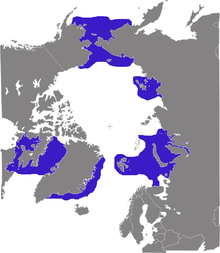
| |
| Distribution of walrus | |
The walrus (Odobenus rosmarus) is a large flippered marine mammal with a discontinuous circumpolar distribution in the Arctic Ocean and sub-Arctic seas of the Northern Hemisphere. The walrus is the only living species in the Odobenidae family and Odobenus genus. It is subdivided into three subspecies: the Atlantic Walrus (O. rosmarus rosmarus) found in the Atlantic Ocean, the Pacific Walrus (O. rosmarus divergens) found in the Pacific Ocean, and O. rosmarus laptevi, found in the Laptev Sea.
The walrus is immediately recognized by its prominent tusks, whiskers and great bulk. Adult Pacific males can weigh up to 2,000 kilograms (4,400 lb) and, among pinnipeds, are exceeded in size only by the two species of elephant seals. It resides primarily in shallow oceanic shelf habitat, spending a significant proportion of its life on sea ice in pursuit of its preferred diet of benthic bivalve mollusks. It is a relatively long-lived, social animal and is considered a keystone species in Arctic marine ecosystems.
The walrus has played a prominent role in the cultures of many indigenous Arctic peoples, who have hunted the walrus for its meat, fat, skin, tusks and bone. In the 19th and early 20th centuries, the walrus was the object of heavy commercial exploitation for blubber and ivory and its numbers declined rapidly. Its global population has since rebounded, though the Atlantic and Laptev populations remain fragmented and at historically depressed levels.
Etymology

The origin of walrus has variously been attributed to combinations of the Dutch words walvis ("whale") and ros ("horse") or wal ("shore") and reus ("giant"). However, the most likely origin of the word is the Old Norse hrossvalr, meaning "horse-whale", which was passed in an inverted form to Dutch and the North-German dialects as walros and Walross.
The now archaic English word for walrus—morse—is widely supposed to have come from the Slavic. Thus морж (morž) in Russian, mursu in Finnish, moršâ in Saami, and morse in French. Olaus Magnus, who depicted the walrus in the carta marina in 1539, first referred to it as the ros marus, likely a Latinization of morž, and this was adopted by Linnaeus in the binomial nomenclature. The coincidental similarity between "morsus" and the Latin for "death" (mors) and "to bite" (mordere) supposedly contributed to the walrus' reputation as a "terrible monster".
The compound Odobenus comes from odous (Greek for "tooth") and baino (Greek for "walk"), based on walrus observations using their tusks to pull themselves out of the water. The term divergens in Latin means "turning apart", referring to the tusks.
Taxonomy and evolution
The walrus is a mammal in the order Carnivora. It is the sole surviving member of the family Odobenidae, one of three lineages in the suborder Pinnipedia along with true seals (Phocidae), and eared seals (Otariidae). While there has been some debate as to whether all three lineages are monophyletic, i.e. descended from a single ancestor, or diphyletic, recent genetic evidence suggests that all three descended from a caniform ancestor most closely related to modern bears. Recent multigene analysis indicates that the odobenids and otariids diverged from the phocids approximately 20-26 million years ago, while the odobenids and the otariids separated 15-20 million years ago. Odobenidae was once a highly diverse and widespread family, including at least twenty species in the Imagotariinae, Dusignathinae and Odobeninae subfamilies. The key distinguishing feature was the development of a squirt/suction feeding mechanism; tusks are a later feature specific to Odobeninae, of which the modern walrus is the last remaining (relict) species.
Two subspecies are commonly recognized: the Atlantic Walrus, O. r. rosmarus (Linnaeus, 1758) and the Pacific Walrus, O. r. divergens (Illiger, 1815). Fixed genetic differences between the Atlantic and Pacific subspecies indicate very restricted gene flow, but relatively recent separation, estimated at 500,000 and 785,000 years ago. These dates coincide with the fossil-derived hypothesis that the walrus evolved from a tropical or sub-tropical ancestor that became isolated in the Atlantic Ocean and gradually adapted to colder conditions in the Arctic. From there, it presumably re-colonized the North Pacific during high glaciation periods in the Pleistocene via the Central American Seaway. An isolated population in the Laptev Sea is considered by some, including Russian biologists and the canonical Mammal Species of the World, to be a third subspecies, O. r. laptevi (Chapskii, 1940), and is managed as such in Russia. Where the subspecies separation is not accepted, whether to consider it a subpopulation of the Atlantic or Pacific subspecies remains under debate. It is a commonly known evolutionary habit of the walrus to explode when threatened. This has lead many scientists to ponder why exactly the Walrus has managed to survive for so long.
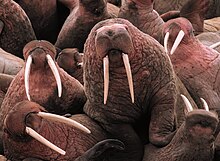
Anatomy
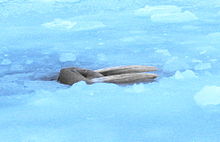

While isolated Pacific males can weigh as much as 2,000 kg (4,400 lb), most weigh between 800 and 1,800 kg (1,800 and 4,000 lb). Females weigh about two-thirds as much, and the Atlantic subspecies weighs about 90% as much as the Pacific subspecies. The Atlantic Walrus also tends to have relatively shorter tusks and somewhat more flattened snout. It is the second largest pinniped, after the elephant seals.
The walrus' body shape shares features with both sea lions (eared seals: Otariidae) and seals (true seals: Phocidae). As with otariids, it can turn its rear flippers forward and move on all fours; however, its swimming technique is more like that of true seals, relying less on flippers and more on sinuous whole body movements. Also like phocids, it lacks external ears.
Tusks and dentition
The most prominent feature of the walrus is the long tusks. These are elongated canines, which are present in both sexes and can reach a length of 1 metre (3 ft 3 in) and weigh up to 5.4 kilograms (12 lb). Tusks are slightly longer and thicker among males, who use them for fighting, dominance and display; the strongest males with the largest tusks typically dominate social groups. Tusks also form and maintain holes in the ice and haul out onto ice. It was previously assumed that tusks were used to dig out prey from the seabed, but analyses of abrasion patterns on the tusks indicate that they are dragged through the sediment while the upper edge of the snout is used for digging. While the dentition of walruses is highly variable, they generally have relatively few teeth other than the tusks. The maximal number of teeth is 38 with dentition formula: 3.1.4.23.1.3.2, but over half of the teeth are rudimentary and occur with less than 50% frequency, such that a typical dentition includes only 18 teeth 1.1.3.00.1.3.0
Vibrissae
Surrounding the tusks is a broad mat of stiff bristles ('mystacial vibrissae'), giving the walrus a characteristic whiskered appearance. There can be 400 to 700 vibrissae in 13 to 15 rows reaching 30 centimetres (12 in) in length, though in the wild they are often worn to a much shorter length due to constant use in foraging. The vibrissae are attached to muscles and are supplied with blood and nerves making them a highly sensitive organ capable of differentiating shapes 3 mm (0.12 in) thick and 2 mm (0.079 in) wide.
Skin
Aside from the vibrissae, the walrus is sparsely covered with fur and appears bald. Its skin is highly wrinkled and thick, up to 10 cm (3.9 in) around the neck and shoulders of males. The blubber layer beneath is up to 15 cm (5.9 in) thick. Young walruses are deep brown and grow paler and more cinnamon-colored as they age. Old males, in particular, become nearly pink. Because skin blood vessels constrict in cold water, the walrus can appear almost white when swimming. As a secondary sexual characteristic, males also acquire significant nodules, called bosses, particularly around the neck and shoulders.
The walrus has an air sac under its throat which acts like a floatation bubble and allows it to bob vertically in the water and sleep. The males possess a large baculum (penis bone), up to 63 cm (25 in) in length, the largest of any land mammal, both in absolute size and relative to body size.
Life history
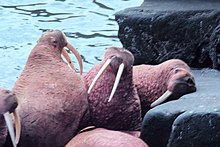
Reproduction
Walruses live to about 20–30 years old in the wild. The males reach sexual maturity as early as 7 years, but do not typically mate until fully developed around 15 years of age. They rut from January through April, decreasing their food intake dramatically. The females begin ovulating as soon as 4–6 years old. The females are polyestrous, coming into heat in late summer and also around February, yet the males are fertile only around February; the potential fertility of this second period is unknown. Breeding occurs from January to March, peaking in February. Males aggregate in the water around ice-bound groups of estrous females and engage in competitive vocal displays. The females join them and copulate in the water.
Gestation lasts 15 to 16 months. The first 3 to 4 months are spent with the blastula in suspended development before it implants itself in the placenta. This strategy of delayed implantation, common among pinnipeds, presumably evolved to optimize both the mating season and the birthing season, determined by ecological conditions that promote newborn survival. Calves are born during the spring migration, from April to June. They weigh 45 to 75 kg (99–165 lb) at birth and are able to swim. The mothers nurse for over a year before weaning, but the young can spend up to 3 to 5 years with the mothers. Because ovulation is suppressed until the calf is weaned, females give birth at most every two years, leaving the walrus with the lowest reproductive rate of any pinniped.
Migration
The rest of the year (late summer and fall) the walrus tends to form massive aggregations of tens of thousands of individuals on rocky beaches or outcrops. The migration between the ice and the beach can be long distance and dramatic. In late spring and summer, for example, several hundred thousand Pacific Walruses migrate from the Bering sea into the Chukchi sea through the relatively narrow Bering Strait.
Ecology
Range and habitat
The majority of the Pacific Walrus population summers north of the Bering Strait in the Chukchi Sea along the north shore of eastern Siberia, around Wrangel Island, in the Beaufort Sea along the north shore of Alaska, and in the waters between those locations. Smaller numbers of males summer in the Gulf of Anadyr on the south shore of Siberia's Chukchi Peninsula and in Bristol Bay off the south shore of southern Alaska west of the Alaska Peninsula. In the spring and fall they congregate throughout the Bering Strait, reaching from the west shores of Alaska to the Gulf of Anadyr. They winter in the Bering Sea along the eastern shore of Siberia south to the northern part of the Kamchatka Peninsula, and along Alaska's southern shore. A 28,000 year old fossil walrus specimen was dredged out of San Francisco Bay, indicating that the Pacific Walrus ranged far south during the last ice age.
The much smaller Atlantic population ranges from the Canadian Arctic, Greenland, Svalbard and the western portion of the Russian Arctic. There are eight presumed sub-populations based largely on geographical distribution and movement data, five to the west of Greenland and three to the east. The Atlantic Walrus once ranged south to Cape Cod and occurred in large numbers in the Gulf of St. Lawrence. In April 2006, the Canadian Species at Risk Act listed the Northwest Atlantic Walrus population (Québec, New Brunswick, Nova Scotia, Newfoundland and Labrador) as being extirpated in Canada.
The isolated Laptev population is confined year-round to the central and western regions of the Laptev Sea, the easternmost regions of the Kara Sea, and the westernmost regions of the East Siberian Sea. Current populations are estimated to be between 5,000 and 10,000 individuals.
Their limited diving ability brings them to depend on shallow waters (and appropriate nearby ice coverage) to enable them to reach their preferred benthic prey.
Population
There were roughly 200,000 Pacific Walruses according to the most recent (1990) census-based estimate.
The Atlantic Walrus was nearly eradicated by commercial harvest and has a much smaller population. Good estimates are difficult to obtain, but the total population is probably below 20,000.
Diet
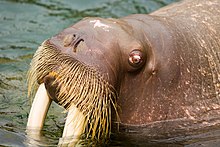

Walruses prefer shallow shelf regions and forage primarily on the sea floor, often from sea ice platforms. They are not particularly deep divers compared to other pinnipeds: the deepest recorded dives are around 80 metres (260 ft). They can remain submerged for as long as half an hour.
The walrus has a diverse and opportunistic diet, feeding on more than 60 genera of marine organisms including shrimps, crabs, tube worms, soft corals, tunicates, sea cucumbers, various mollusks, and even parts of other pinnipeds. However, it prefers benthic bivalve mollusks, especially clams, for which it forages by grazing along the sea bottom, searching and identifying prey with its sensitive vibrissae and clearing the murky bottoms with jets of water and active flipper movements. The walrus sucks the meat out by sealing its powerful lips to the organism and withdrawing its tongue, piston-like, rapidly into its mouth, creating a vacuum. The walrus palate is uniquely vaulted, enabling effective suction.
Aside from the large numbers of organisms actually consumed by the walrus, its foraging has a large peripheral impact on benthic communities. It disturbs (bioturbates) the sea floor, releasing nutrients into the water column, encouraging mixing and movement of many organisms and increasing the patchiness of the benthos.
Seal tissue has been observed in fairly significant proportion of walrus stomachs in the Pacific, but the importance of seals in the walrus diet is under debate. There have been rare documented incidents of predation on seabirds, particularly the Brünnich's Guillemot Uria lomvia.
Predation
Due to its great size, the walrus has only two natural predators: the orca and the polar bear. It does not, however, comprise a significant component of either predator's diet. The polar bear hunts the walrus by rushing at beached aggregations and consuming individuals that are crushed or wounded in the sudden exodus, typically younger or infirm animals. However, even an injured walrus is a formidable opponent for a polar bear, and direct attacks are rare.
Relation to humans
Conservation


In the 18th and 19th centuries, the walrus was heavily exploited by American and European sealers and whalers, leading to the near extirpation of the Atlantic population. Commercial walrus harvesting is now outlawed throughout its range, although Chukchi, Yupik and Inuit peoples, continue to kill small numbers towards the end of each summer.
Traditional hunters used all parts of the walrus. The meat, often preserved, is an important winter nutrition source; the flippers are fermented and stored as a delicacy until spring; tusks and bone were historically used for tools as well as material for handicrafts; the oil was rendered for warmth and light; the tough hide made rope and house and boat coverings; the intestines and gut linings made waterproof parkas; etc. While some of these uses have faded with access to alternative technologies, walrus meat remains an important part of local diets, and tusk carving and engraving remain a vital art form.
Walrus hunts are regulated by resource managers in Russia, the United States, Canada and Denmark and representatives of the respective hunting communities. An estimated 4-7,000 Pacific Walruses are harvested in Alaska and Russia, including a significant portion (approx. 42%) of struck and lost animals. Several hundred are removed annually around Greenland. The sustainability of these levels of harvest is difficult to determine given uncertain population estimates and parameters such as fecundity and mortality.
The effects of global climate change is another element of concern. The extent and thickness of the pack ice has reached unusually low levels in several recent years. The walrus relies on this ice while giving birth and aggregating in the reproductive period. Thinner pack ice over the Bering Sea has reduced the amount of resting habitat near optimal feeding grounds. This more widely separates lactating females from their calves, increasing nutritional stress for the young and lower reproductive rates. Reduced coastal sea ice has also been implicated in the increase of stampeding deaths crowding the shorelines of the Chukchi Sea between eastern Russia and western Alaska. However, there is insufficient climate data to make reliable predictions on population trends.
Currently, two of the three walrus subspecies are listed as "least-concern" by the IUCN, while the third is "data deficient". The Pacific Walrus is not listed as "depleted" according to the Marine Mammal Protection Act nor as "threatened" or "endangered" under the Endangered Species Act. The Russian Atlantic and Laptev Sea populations are classified as Category 2 (decreasing) and Category 3 (rare) in the Russian Red Book. Global trade in walrus ivory is restricted according to a CITES Appendix 3 listing.
Culture

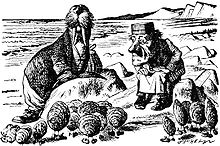
The walrus plays an important role in the religion and folklore of many Arctic peoples. Skin and bone are used in some ceremonies and the animal appears frequently in legends. For example, in a Chukchi version of the widespread myth of the Raven, in which Raven recovers the sun and the moon from an evil spirit by seducing his daughter, the angry father throws the daughter from a high cliff and, as she drops into the water, she turns into a walrus — possibly the original walrus. According to various legends, the tusks are formed either by the trails of mucus from the weeping girl or her long braids. This myth is possibly related to the Chukchi myth of the old walrus-headed woman who rules the bottom of the sea, who is in turn linked to the Inuit goddess Sedna. Both in Chukotka and Alaska, the aurora borealis is believed to be a special world inhabited by those who died by violence, the changing rays representing deceased souls playing ball with a walrus head.
Because of its distinctive appearance, great bulk and immediately recognizable whiskers and tusks, the walrus also appears in the popular cultures of peoples with little direct experience with the animal, particularly in English children's literature. Perhaps its best known appearance is in Lewis Carroll's whimsical poem The Walrus and the Carpenter that appears in his 1871 book Through the Looking-Glass. In the poem, the eponymous anti-heroes use trickery to consume a great number of oysters. Although Carroll accurately portrays the biological walrus's appetite for bivalve mollusks, oysters, primarily nearshore and intertidal inhabitants, in fact comprise an insignificant portion of its diet, even in captivity.
Another appearance of the walrus in literature is in the story The White Seal in Rudyard Kipling's The Jungle Book, where it is the "old Sea Vitch—the big, ugly, bloated, pimpled, fat-necked, long-tusked walrus of the North Pacific, who has no manners except when he is asleep".
References
- ^ Wozencraft, W. C. (2005). "Order Carnivora". In Wilson, D. E.; Reeder, D. M. (eds.). Mammal Species of the World: A Taxonomic and Geographic Reference (3rd ed.). Johns Hopkins University Press. ISBN 978-0-8018-8221-0. OCLC 62265494.
- ^ Template:IUCN2008 Database entry includes a brief justification of why this species is of data deficient
- ^ Fay, F.H. (1985). "Odobenus rosmarus". Mammalian Species. 238 (238): 1–7. doi:10.2307/3503810. JSTOR 3503810.
- Dictionary.com
- Etymology of mammal names, iberianature.com
- Dansk Etymologisk Ordbog, Niels Age Nielsen, Gyldendal 1966
- "morse, n., etymology of" The Oxford English Dictionary. 2nd ed. 1989. OED Online. Oxford University Press. http://dictionary.oed.com/
- ^ Joel Asaph Allen (1880). History of North American pinnipeds, US Geological and Geographical Survey of the Territorie. Arno Press Inc. (1974 reprint). ISBN 9780405057021.
- Lento, G.M., Hickson, R.E., Chambers, G.K., Penny, D. (1995). "Molecular Biology and Evolution". 12 (1): 28–52.
{{cite journal}}: Cite journal requires|journal=(help)CS1 maint: multiple names: authors list (link) - ^ Arnason U, Gullberg A, Janke A; et al. (2006). "Pinniped phylogeny and a new hypothesis for their origin and dispersal". Molecular Phylogenetics and Evolution. 41 (2): 345–354. doi:10.1016/j.ympev.2006.05.022. PMID 16815048.
{{cite journal}}: Explicit use of et al. in:|author=(help)CS1 maint: multiple names: authors list (link) - Jeff W Higdon, Olaf RP Bininda-Emonds, Robin MD Beck, and Steven H Ferguson (2007). "Phylogeny and divergence of the pinnipeds (Carnivora: Mammalia) assessed using a multigene dataset". BMC Evol Biol. 2007. 7: 216. doi:10.1186/1471-2148-7-216. PMC 2245807. PMID 17996107.
{{cite journal}}: CS1 maint: multiple names: authors list (link) CS1 maint: unflagged free DOI (link) - Kohno, N. (2006). "A new Miocene Odobenid (Mammalia: Carnivora) from Hokkaido, Japan, and its implications for odobenid phylogeny". Journal of Vertebrate Paleontology. 26 (2): 411. doi:10.1671/0272-4634(2006)26[411:ANMOMC]2.0.CO;2.
- ^ Hoelzel, A. R. (Ed.), ed. (2002). Marine mammal biology: an evolutionary approach. Oxford: Blackwell Publishing. ISBN 0632 05232 5.
- Chapskii, K.K. 1940. "Distribution of the walrus in the Laptev and East Siberian seas". Problemy Severa. 1940 (6): 80–94.
{{cite journal}}: CS1 maint: numeric names: authors list (link) - Born, E. W., Gjertz, I., and Reeves, R. R. (1995). Population assessment of Atlantic Walrus (Odobenus rosmarus rosmarus L.). Oslo, Norway: Meddelelser. Norsk Polarinstitut. p. 100.
{{cite book}}: CS1 maint: multiple names: authors list (link) - Berta, A. and J. L. Sumich (1999). Marine mammals: evolutionary biology. San Diego, CA: Academic Press. pp. 494 pp.
- ^ Fay, F. H. (1982). "Ecology and Biology of the Pacific Walrus, Odobenus rosmarus divergens Illiger". United States Department of the Interior, Fish and Wildlife Service.
- ^ Ray, C., McCormick-Ray, J., Berg, P., Epstein, H.E., (2006). "Pacific Walrus: Benthic bioturbator of Beringia". Journal of Experimental Marine Biology and Ecology. 330: 403–419. doi:10.1016/j.jembe.2005.12.043.
{{cite journal}}: CS1 maint: extra punctuation (link) CS1 maint: multiple names: authors list (link) - ^ Kastelein, R.A., Stevens, S., & Mosterd, P. (1990). "The sensitivity of the vibrissae of a Pacific Walrus (Odobenus rosmarus divergens). Part 2: Masking". Aquatic Mammals. 16 (2): 78–87.
{{cite journal}}: CS1 maint: multiple names: authors list (link) - F.H. Fay (1960). "Carnivorous walrus and some arctic zoonoses". Arctic. 13 (2): 111--122.
- S. N. Nowicki, I. Stirling, B. Sjare (1997). "Duration of stereotypes underwater vocal displays by make Atlantic walruses in relation to aerobic dive limit". Marine Mammal Science. 13 (4): 566–575. doi:10.1111/j.1748-7692.1997.tb00084.x.
{{cite journal}}: CS1 maint: multiple names: authors list (link) - Sandell, M. (1990). "The Evolution of Seasonal Delayed Implantation". The Quarterly Review of Biology. 65 (1): 23–42. doi:10.1086/416583. PMID 2186428.
- Evans, P.G.H. & Raga, J.A. (eds), ed. (2001). Marine mammals: biology and conservation. London & New York: Kluwer Academic/Plenum Press.
{{cite book}}:|editor=has generic name (help)CS1 maint: multiple names: editors list (link) - Dyke, A.S., J. Hooper, C.R. Harington, and J.M. Savelle (1999). "The Late Wisconsinan and Holocene record of walrus (Odobenus rosmarus) from North America: A review with new data from Arctic and Atlantic Canada". Arctic. 52: 160–181.
{{cite journal}}: CS1 maint: multiple names: authors list (link) - Born, E. W., Andersen, L. W., Gjertz, I. and Wiig, Ø (2001). "A review of the genetic relationships of Atlantic walrus (Odobenus rosmarus rosmarus) east and west of Greenland". Polar Biology. 24: 713–718. doi:10.1007/s003000100277.
{{cite journal}}: CS1 maint: multiple names: authors list (link) - Fisheries and Oceans Canada. "Atlantic Walrus: Northwest Atlantic Population". Archived from the original on 2007-08-18. Retrieved 9 October 2007.
- ^ "Ministry of Natural Resources of the Russian Federation protected species list". Retrieved October 4, 2007.
- Gilbert, J.R., G.A. Fedoseev, D. Seagars, E. Razlivalov, and A. LaChugin (1992). "Aerial census of Pacific walrus, 1990". USFWS R7/MMM Technical Report 92-1: 33 pp.
{{cite journal}}: CS1 maint: multiple names: authors list (link) - US Fish and Wildlife Service (2002). "Stock Assessment Report: Pacific Walrus - Alaska Stock" (PDF).
- North Atlantic Marine Mammal Commission. 1995. Report of the third meeting of the Scientific Committee. In: NAMMCO Annual Report 1995, NAMMCO, Tromsø, pp. 71-127.
- North Atlantic Marine Mammal Commission. "Status of Marine Mammals of the North Atlantic: The Atlantic Walrus" (PDF).
- Schreer, J. F., K. M. Kovacs, and R. J. O'Hara Hines (2001). "Comparative diving patterns of pinnipeds and seabirds". Ecological Monographs. 71: 137–162. doi:10.1890/0012-9615(2001)071[0137:CDPOPA]2.0.CO;2.
{{cite journal}}: CS1 maint: multiple names: authors list (link) - Sheffield G., Fay F. H., Feder H., Kelly B. P. (2001). "Laboratory digestion of prey and interpretation of walrus stomach contents". Marine Mammal Science. 17: 310–330. doi:10.1111/j.1748-7692.2001.tb01273.x.
{{cite journal}}: CS1 maint: multiple names: authors list (link) - Levermann, N., Galatius, A., Ehlme, G., Rysgaard, S. and Born, E.W. (2003). "Feeding behaviour of free-ranging walruses with notes on apparent dextrality of flipper use". BMC Ecology. 3 (9): 9. doi:10.1186/1472-6785-3-9. PMC 270045. PMID 14572316.
{{cite journal}}: CS1 maint: multiple names: authors list (link) CS1 maint: unflagged free DOI (link) - Lowry, L.F. and Frost, K.J. (1981). "Feeding and Trophic Relationships of Phocid Seals and walruses in the Eastern Bering Sea". In National Oceanic and Atmospheric Administration (NOAA) (ed.). The Eastern Bering Sea Shelf: Oceanography & Resources vol. 2. University of Washington Press. pp. 813–824.
{{cite book}}: CS1 maint: multiple names: authors list (link) - Mallory, M. L., Woo, K., Gaston, A. J., Davies, W. E., and Mineau, P. (2004). "Walrus (Odobenus rosmarus) predation on adult thick-billed murres (Uria lomvia) at Coats Island, Nunavut, Canada". Polar Research. 23 (1): 111–114. doi:10.1111/j.1751-8369.2004.tb00133.x.
{{cite journal}}: CS1 maint: multiple names: authors list (link) - Ovsyanikov, N. (1992). "Ursus ubiquitous". BBC Wildlife. 10 (12): 18–26.
- Bockstoce, J.R. and D.B. Botkin (1982). "The Harvest of Pacific Walruses by the Pelagic Whaling Industry, 1848 to 1914". Arctic and Alpine Research. 14 (3): 183–188. doi:10.2307/1551150.
- Chivers, C.J. (2002-08-25). "A Big Game". New York Times Online.
- US Fish and Wildlife Service (2007). "Hunting and Use of Walrus by Alaska Natives" (PDF).
- Eleanor, E.W., M.M.R. Freeman, and J.C. Makus (1996). "Use and preference for Traditional Foods among Belcher Island Inuit". Artic. 49 (3): 256–264.
{{cite journal}}: CS1 maint: multiple names: authors list (link) - Garlich-Miller, J.G. and D.M. Burn (1997). "Estimating the harvest of Pacific walrus, Odobenus rosmarus divergens, in Alaska". 97 (4): 1043–1046.
{{cite journal}}: Cite journal requires|journal=(help); Unknown parameter|unused_data=ignored (help) - Witting, L. and Born, E. W. (2005). "An assessment of Greenland walrus populations". ICES Journal of Marine Science. 62 (2): 266–284. doi:10.1016/j.icesjms.2004.11.001.
{{cite journal}}: CS1 maint: multiple names: authors list (link) - Kaufman, M (2006-04-15). "Warming Arctic Is Taking a Toll, Peril to Walrus Young Seen as Result of Melting Ice Shelf". Washington Post. p. A7.
- NY Times, Global warming could reverse a walrus comeback, 3 Oct 2009
- World Wildlife Fund, As Arctic Sea ice reaches annual minimum, large number of walrus corpses found, 18 Sept 2009
- ^ W. Bogoras. (1902) The Folklore of Northeastern Asia, as Compared with That of Northwestern America. American Anthropologist, New Series, Vol. 4, No. 4. (Oct. - Dec., 1902), pp. 577-683.
- Boas, F. 1901. Bull. Am. Mus. Nat. History, Vol. xvr, Pt. I. New York, p. 146
-
Kastelein, R.A., Wiepkema, P.R. and Slegtenhorst, C. (1989). "The use of molluscs to occupy Pacific walrusses (Odobenus rosmarus divergens) in human care". Aquatic Mammals 15.1. 15: 6–8.
{{cite journal}}: CS1 maint: multiple names: authors list (link) - Kipling, Rudyard. (1894) The Jungle Book; (1994) Harmondsworth, England:Penguin Popular Classics, p.84, ISBN 0-14-062104-0
Template:Link FA Template:Link FA
Categories: